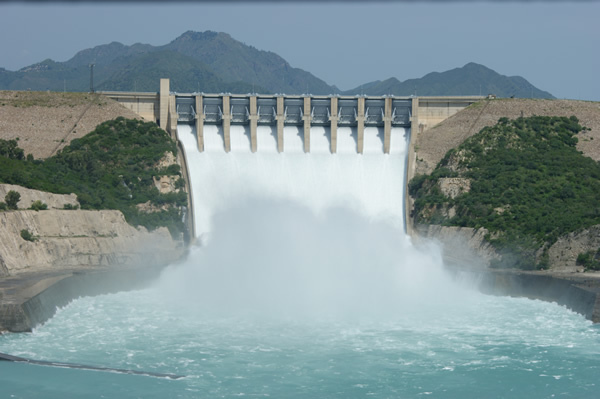As Pakistan battles the ferocious waves of its angry rivers, Mirza Asif Baig, chairman of the Indus Water Commission (IWC), argues the destruction of the floods could have been averted if the country had invested more in dams.
While Pakistan is currently wracked by floods, for most of the year the arid country has little rain. This year’s floods have killed almost 500 people in Pakistan and Indian administered Kashmir, displaced hundreds of thousands more and destroyed swathes of cotton crops. But most of the water dumped during the monsoon deluge will be wasted.
Baig laments the loss of the “precious resource” and believes the answer lies in building big dams on the Indus River. But big dams have become a politically charged issue. “The sensitivity leant to the dam issue has damaged the national point of view,” he told thethirdpole.net.
In May this year, Prime Minister Nawaz Sharif gave the green light for construction of the 4,500-megawatt Diamer-Bhasha Dam and the 2,000 megawatt Dasu Hydropower Project on the Indus river.
Akhtar Ali, a water specialist at the Asian Development Bank believes these new reservoirs are crucial, given the country’s looming water and energy crises, against a backdrop of rapid urbanisation, population growth, food insecurity and growing water demand from industry.
“Dams facilitate water regulation; it is up to us how we manage that,” he said. “The increased storage capacity from building new reservoirs could store floodwater for productive use and lessen flood peaks downstream,” he added.
Dams also provide valuable water storage for agriculture, Baig pointed out. “If we can control water by investing in big dams we can overcome the electricity crisis and improve our agriculture.”
The Indus basin irrigates about 14 million hectares of land in Pakistan – the largest irrigated area in the world – for which a huge amount of water is needed. With only two existing major reservoirs in the Indus basin – the Mangla and Tarbela – the storage capacity of Pakistan is only about 30 days, while most of the developed countries have 1-2 years water storage capability.
Pakistan is fast becoming a water scarce country. “Pakistan’s per capita water availability is presently estimated at 950 cubic metres, quite a dip from 5,500 cubic metres in 1951,” said Ghulam Rasul, deputy director general of the Pakistan Meteorological Department. “If we continue business as usual, how will we meet the water needs of a growing population?”
However, not everyone agrees that dams are the best solution. Professor Mushtaq Mirani, director of the Centre of Engineering and Development at the Mehran University of Engineering and Technology in Sindh province, believes dam proponents fail to take into account the hydrologic changes that may result from building dams.
“The conversation about dams takes place after every flood,” he said, but most dam proponents come from the upstream Punjab province. The Kalabagh dam, a hydroelectric project planned on the Indus River in Punjab has been a bone of contention for over three decades. It has strong support in Punjab, Pakistan’s largest province, but Sindh and Khyber Pakhtunkhwa fiercely oppose the 3,600 megawatt dam which they argue would give Punjab control over their water.
“Before a big dam has to be built, one has to understand the natural flow regime very carefully as dams can heavily modify the volume of water flowing downstream,” Mirani, also an engineer, pointed out.
Mirani, an opponent of big dams, says construction of big reservoirs require huge investment, displacement of local communities and loss of rich biodiversity.
Others fear big dams could become easy targets for militants, as the Mosul dam recently became in Iraq.
A recent study from Oxford University’s Said Business School concluded that mega dams are not economically viable and come at great human and ecological cost. Little independent research on the viability of large dams has been carried out since the findings of the World Commission on Dams in 2000. And by 2000, the number of large dams had climbed to more than 47,000, and an additional 800,000 smaller dams blocked the flow of the world’s rivers.
The Oxford study, based on data from 245 large dams in 65 countries, claims dam building has burdened countries with large amounts of debt. It argues “smaller, more flexible hydroelectric projects” built faster should be the preferred choice. After a decade-long “lull” in dam building, emerging economies of Brazil, China, Ethiopia and Pakistan among others are rushing to build mega-dams on an unprecedented scale, the report claims.
Pakistan dams not the only solution
Shafqat Kakakhel, former ambassador and former official of the United Nations Environment Programme, argues big dams are “not the only or the best solution for diverting and storing flood water. Dams of various sizes should be seen as one of the numerous interventions for managing the kind of floods that we have seen in recent years and are likely to experience in future thanks to climate change and other factors.”
Mirani insists that before building dams Pakistan needs to put its irrigation system in order. “We waste nearly 60% of water because of our outdated canal and irrigation system. In addition, we still practise flood irrigation when we should be turning towards controlled irrigation.” He claims Pakistan has enough water even to divert it towards the drought-stricken Thar desert, the Indus delta where sea water intrusion is destroying swathes of agricultural land or even to urban centres like Karachi, which is experiencing water shortages.
The benefits and challenges of each project need to be weighed up. “I acknowledge the plight of the communities displaced by huge dams,” said Kakakhel. “But we also need to look at the enormous benefits of the Three Gorges Project such as production of huge quantity of electricity and controlling floods in the Yangtze basin,” he said.
Often hydropower supplies cities while communities close to the project remain in the dark. Kakakhel agrees, citing the example of Kashmiris, in Indian-administered part of Kashmir, who complain that while dams use their water and land to generate power for the rest of India, the valley itself frequently suffers from black-outs of the type endured by Pakistanis. “But such complaints can be addressed without abandoning a hydropower project that is otherwise necessary,” he added.
Kakakhel still favours dams over solar and wind energy, since multi-purpose dams do “much more than electricity generation” as seen in the case of the Tarbela and Mangla dams “which expanded cultivable areas”.

